2018 MERCEDES-BENZ CLA fuel pressure
[x] Cancel search: fuel pressurePage 295 of 326

R
wear excessively and/or unevenly R
have an adverse effect on fuel consumption
Overinflated tires
G WARNING
Tires with excessively high pressure can burst
becaus et he ya re damaged mor ee asily by
road debris ,p otholes etc .Ina ddition, they
also suffer fro mi rregular wear, which can
severely impair th eb raking properties and the
driving characteristics. Ther eisar isk of an
accident.
Avoid tir ep ressures that are too high in all the
tires, including th es pare wheel.
Overinflated tires may: R
increase th eb raking distanceR
adversely affect handling R
wear excessively and/or unevenly R
have an adverse effect on ride comfort R
be mor es usceptible to damage
Maximu mt ir ep re ssures
�C
Example: maximum permissible tir ep res-
sure
Never exceed th em aximum permissible tire
inflatio np ressure. Always observe th er ecom-
mended tir ep ressure for your vehicle when
adjustin gt he tir ep ressure ( Y
page 290).
i The actual values for tires are vehicle-spe-
cific and may deviat ef ro mt he values in the
illustration. Checking th et ir ep re ssures
Important safety notes Observe th en otes on tir ep ressure
( Y
page 290).
Information on air pressure for th et ires on your
vehicle can be found: R
on th ev ehicle's Tire and Loadin gI nf ormation
placar dont he B-pillar R
in th et ir ep ressure table in th ef uel filler flap
( Y
page 139) R
in th e" Tire pressure" section
Checking tir ep re ssures manuallyTo determine and set th ec orrec tt ir ep ressure,
proceed as follows: X
Remov et he valve cap of th et ir et ha tistob e
checked. X
Pres st he tir ep ressure gauge securely onto
th ev alve. X
Read th et ir ep ressure and compare it to the
recommended value on th eT ire and Loading
Information placar dort he tir ep ressure table
( Y
page 290). X
If th et ir ep ressure is too low, increase th et ire
pressure to th er ecommended value. X
If th et ir ep ressure is too high, releas ea ir. To
do so, pres sd own th em etal pin in th ev alve,
using th et ip of ap en for example. Then check
th et ir ep ressure again using th et ir ep ressure
checker. X
Screw th ev alve cap ont ot he valve.X
Repeat these steps for th eo ther tires.
Tir ep re ssur el oss warning system
(Canada only)
General notes While th ev ehicle is in motion, th et ir ep ressure
loss warning system monitors th es et tir ep res-
sure using th er otational speed of th ew heels.
This enables th es ystem to detect significant
pressure loss in at ire. If th es peed of rotation of
aw heel changes as ar esult of al oss of pressure,
ac orresponding warning message will appear in
th em ultifunction display.
You can recognize th et ir ep ressure loss warning
by the Run Flat Indicato rA ctive PressTir ep re ssure 293
Wheels and tires Z
Page 296 of 326
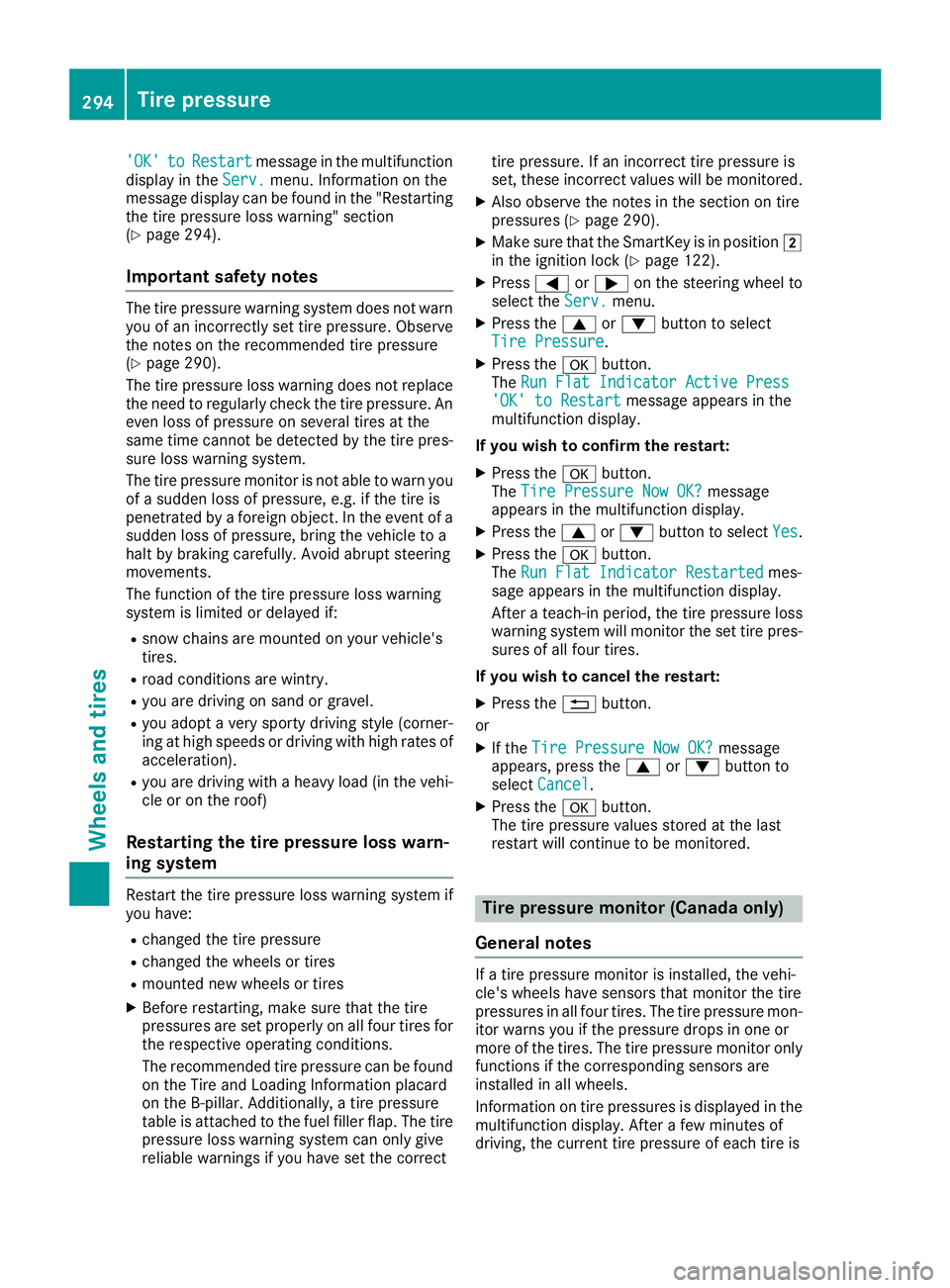
'OK' to Restart message in the multifunction
displa yint he Serv. menu. Information on the
message displa yc an be found in the "Restarting
the tire pressure loss warning" section
( Y
page 294).
Important safety notes The tire pressure warning system does not warn
you of an incorrectly set tire pressure. Observe
the notes on the recommended tire pressure
( Y
page 290).
The tire pressure loss warning does not replace
the need to regularly check the tire pressure. An
even loss of pressure on several tires at the
same time cannot be detected by the tire pres-
sure loss warning system.
The tire pressure monitor is not able to warn you
of as udden loss of pressure, e.g. if the tire is
penetrated by af oreign object. In the event of a
sudden loss of pressure, bring the vehicle to a
halt by braking carefully .A void abrupt steering
movements.
The function of the tire pressure loss warning
system is limited or delayed if: R
snow chains are mounted on your vehicle's
tires. R
road conditions are wintry. R
you are driving on sand or gravel. R
you adopt av ery sporty driving style (corner-
ing at high speeds or driving with high rates of
acceleration). R
you are driving with ah eavy load (in the vehi-
cle or on the roof)
Restarting the tire pressure loss warn-
ing system Restart the tire pressure loss warning system if
you have: R
changed the tire pressure R
changed the wheels or tires R
mounted new wheels or tires X
Before restarting, make sure that the tire
pressures are set properly on all four tires for
the respective operating conditions.
The recommended tire pressure can be found
on the Tire and Loading Information placard
on the B-pillar. Additionally ,at ire pressure
table is attached to the fuel filler flap. The tire
pressure loss warning system can only give
reliable warnings if you have set the correct tire pressure. If an incorrect tire pressure is
set, these incorrect value sw ill be monitored.X
Also observe the notes in the section on tire
pressures ( Y
page 290). X
Make sure that the SmartKey is in position �H
in the ignition lock ( Y
page 122).X
Press �Y or �e on the steering wheel to
select the Serv. menu.X
Press the �c or �d button to select
Tire Pressure . X
Press the �v button.
The Run Flat Indicator Active Press
'OK' to Restart message appears in the
multifunction display.
If you wish to confirm the restart: X
Press the �v button.
The Tire Pressure Now OK? message
appears in the multifunction display. X
Press the �c or �d button to select Yes .X
Press the �v button.
The Run Flat Indicator Restarted mes-
sage appears in the multifunction display.
After at each-in period, the tire pressure loss
warning system will monitor the set tire pres-
sures of all four tires.
If you wish to cance lt he restart:X
Press the �8 button.
or X
If the Tire Pressure Now OK? message
appears, press the �c or �d button to
select Cancel . X
Press the �v button.
The tire pressure value ss tored at the last
restart will continue to be monitored.
Tire pressure monitor (Canada only)
General notes If at ire pressure monitor is installed, the vehi-
cle's wheels have sensors that monitor the tire
pressures in all four tires. The tire pressure mon-
itor warns you if the pressure drops in one or
more of the tires. The tire pressure monitor only
functions if the corresponding sensors are
installed in all wheels.
Information on tire pressures is displayed in the
multifunction display. After af ew minutes of
driving, the current tire pressure of each tire is294
Tire pressure
Wheels and tires
Page 297 of 326
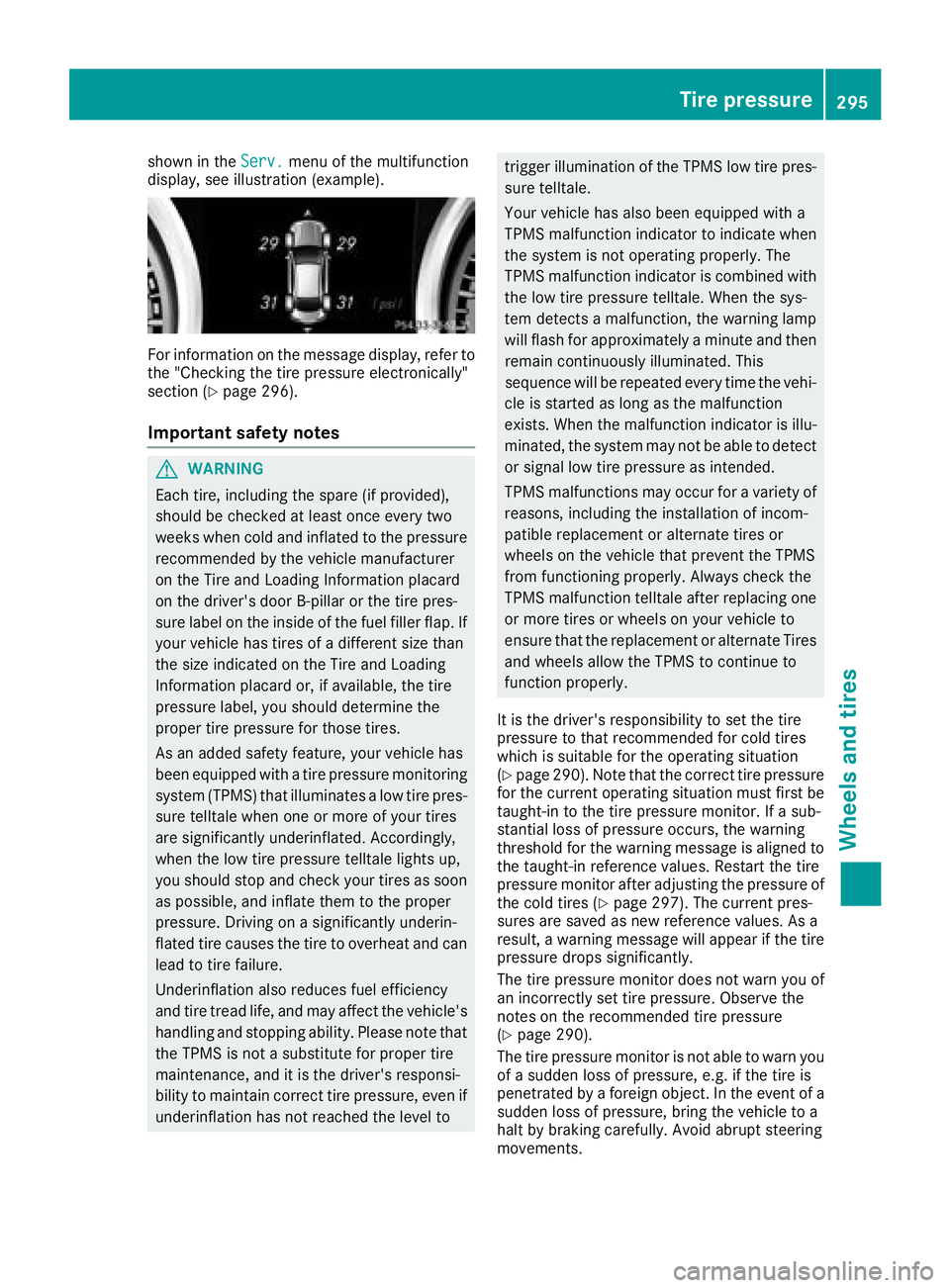
shown in the Serv. menu of the multifunction
display, see illustration (example).
For information on the message display, refer to
the "Checking the tire pressure electronically"
section ( Y
page 296).
Important safety notes
G WARNING
Each tire, including the spare (if provided),
should be checked at least once every two
weeks when cold and inflated to the pressure
recommended by the vehicle manufacturer
on the Tire and Loading Information placard
on the driver's door B-pillar or the tire pres-
sure label on the inside of the fuel filler flap. If
your vehicle has tires of ad ifferent size than
the size indicated on the Tire and Loading
Information placard or, if available, the tire
pressure label ,y ou should determine the
proper tire pressure for those tires.
As an added safety feature, your vehicle has
been equipped with at ire pressure monitoring
system (TPMS) that illuminates al ow tire pres-
sure telltale when one or more of your tires
are significantly underinflated. Accordingly,
when the low tire pressure telltale lights up,
you should stop and check your tires as soon
as possible ,a nd inflate them to the proper
pressure. Driving on as ignificantly underin-
flated tire causes the tire to overheat and can
lead to tire failure.
Underinflation also reduces fuel efficiency
and tire tread life, and may affect the vehicle's
handling and stopping ability. Please note that
the TPMS is not as ubstitute for proper tire
maintenance, and it is the driver's responsi-
bility to maintain correct tire pressure, even if
underinflation has not reached the level to trigger illumination of the TPMS low tire pres-
sure telltale.
Your vehicle has also been equipped with a
TPMS malfunction indicator to indicate when
the system is not operating properly. The
TPMS malfunction indicator is combined with
the low tire pressure telltale. When the sys-
tem detects am alfunction, the warning lamp
will flash for approximately am inute and then
remain continuously illuminated. This
sequence will be repeated every time the vehi-
cle is started as long as the malfunction
exists. When the malfunction indicator is illu-
minated, the system may not be able to detect
or signal low tire pressure as intended.
TPMS malfunctions may occur for av ariety of
reasons, including the installation of incom-
patible replacement or alternate tires or
wheels on the vehicle that prevent the TPMS
from functionin gp roperly. Always check the
TPMS malfunction telltale after replacing one
or more tires or wheels on your vehicle to
ensure that the replacement or alternate Tires
and wheels allow the TPMS to continue to
function properly.
It is the driver's responsibility to set the tire
pressure to that recommended for cold tires
which is suitable for the operating situation
( Y
page 290). Note that the correct tire pressure
for the current operating situation must first be
taught-in to the tire pressure monitor. If as ub-
stantial loss of pressure occurs, the warning
threshold for the warning message is aligned to
the taught-in reference values. Restart the tire
pressure monitor after adjusting the pressure of
the cold tires ( Y
page 297). The current pres-
sures are saved as new reference values. As a
result, aw arning message will appea rift he tire
pressure drops significantly.
The tire pressure monitor does not warn you of
an incorrectly set tire pressure. Observe the
notes on the recommended tire pressure
( Y
page 290).
The tire pressure monitor is not able to warn you
of as udden loss of pressure, e.g. if the tire is
penetrated by af oreign object. In the event of a
sudden loss of pressure, bring the vehicle to a
halt by braking carefully .A void abrupt steering
movements. Tire pressure 295
Wheels and tires Z
Page 300 of 326
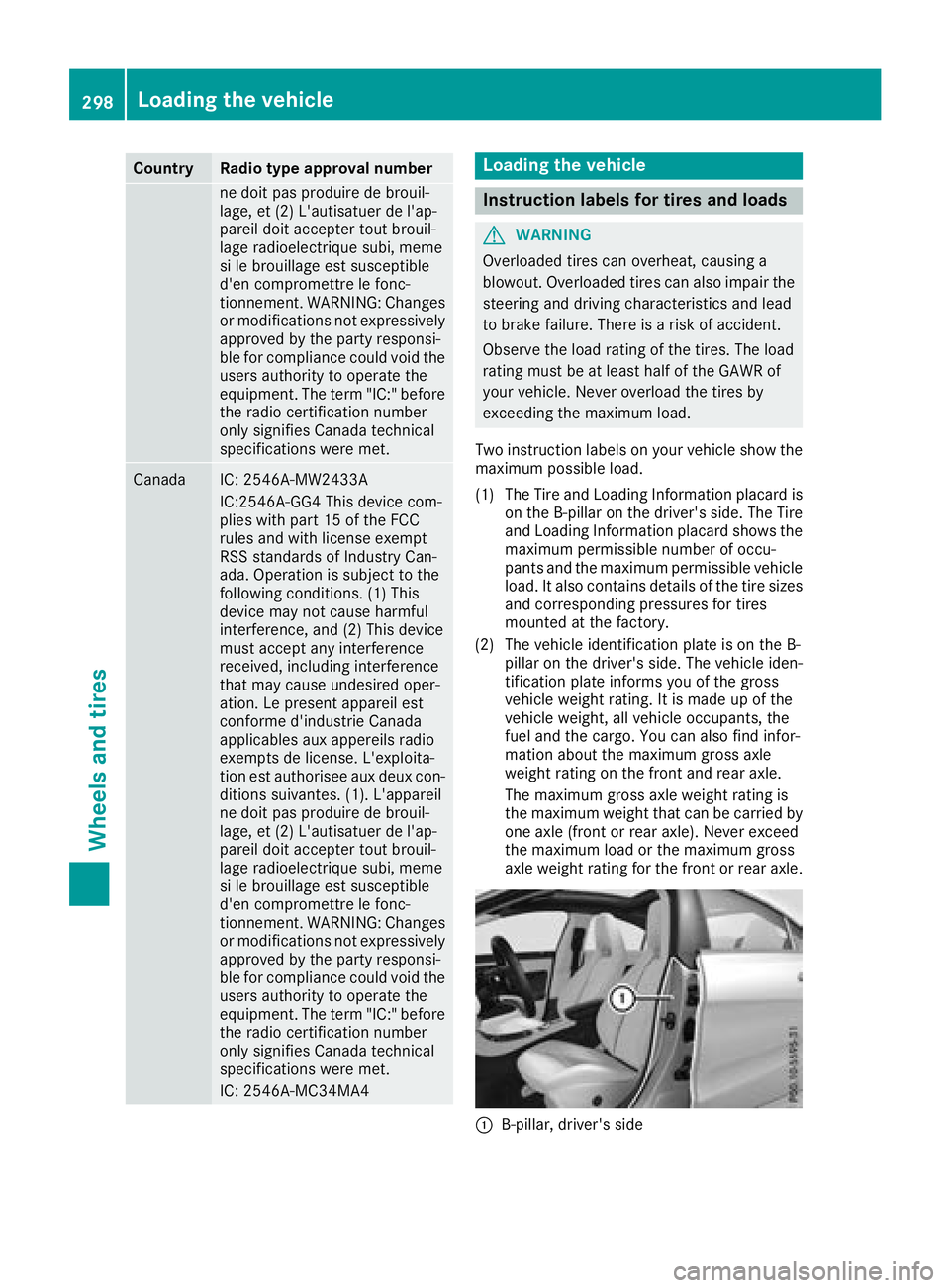
Country Radio type approval number
ne doit pas produire de brouil-
lage, et (2) L'autisatuer de l'ap-
pareil doit accepter tout brouil-
lage radioelectrique subi, meme
si le brouillage est susceptible
d'en compromettre le fonc-
tionnement. WARNING: Changes
or modifications not expressively
approved by th ep art yr esponsi-
ble for compliance could void the
users authorit yt oo perate the
equipment .T he ter m" IC: "b efore
th er adio certification number
onl ys ignifies Canada technical
specifications were met.
Canada IC: 2546A-MW2433A
IC:2546A-GG4 This devic ec om-
plies with part 15 of th eF CC
rules and with licens ee xempt
RSS standards of Industry Can-
ada. Operatio niss ubject to the
following conditions. (1) This
devic em ay not cause harmful
interference, and (2) This device
must accept any interference
received ,i ncludin gi nterference
that may cause undesire do per-
ation. Le present appareil est
conforme d'industrie Canada
applicables aux appereils radio
exempt sdel icense. L'exploita-
tio ne st authorisee aux deux con-
dition ss uivantes .( 1). L'appareil
ne doit pas produire de brouil-
lage, et (2) L'autisatuer de l'ap-
pareil doit accepter tout brouil-
lage radioelectrique subi, meme
si le brouillage est susceptible
d'en compromettre le fonc-
tionnement. WARNING: Changes
or modifications not expressively
approved by th ep art yr esponsi-
ble for compliance could void the
users authorit yt oo perate the
equipment .T he ter m" IC: "b efore
th er adio certification number
onl ys ignifies Canada technical
specifications were met.
IC: 2546A-MC34MA4 Loading th ev ehicle
Instruction labels for tires and loads
G WARNING
Overloade dt ires can overheat ,c ausing a
blowout .O verloade dt ires can also impair the
steerin ga nd driving characteristic sa nd lead
to brak ef ailure. Ther eisar isk of accident.
Observe th el oad rating of th et ires. The load
rating must be at least half of th eG AWR of
your vehicle .N ever overload th et ires by
exceedin gt he maximum load.
Two instruction labels on your vehicle show the
maximum possible load.
(1) The Tire and Loadin gI nf ormation placar di s
on th eB -p illar on th ed river' ss ide. The Tire
and Loadin gI nf ormation placar ds hows the
maximum permissible number of occu-
pant sa nd th em aximum permissible vehicle
load. It also contain sd etails of th et ir es izes
and corresponding pressures for tires
mounted at th ef actory.
(2) The vehicle identification plat eisont he B-
pillar on th ed river' ss ide. The vehicle iden-
tification plat ei nform sy ou of th eg ross
vehicle weight rating .Itism ade up of the
vehicle weight ,a ll vehicle occupants, the
fuel and th ec argo. You can also fin di nfor-
mation about th em aximum gross axle
weight rating on th ef ront and rear axle.
The maximum gross axle weight rating is
th em aximum weight that can be carried by
one axle (front or rear axle) .N ever exceed
th em aximum load or th em aximum gross
axle weight rating for th ef ront or rear axle.
�C
B-pillar ,d river' ss ide298
Loading th ev ehicle
Wheels and tires
Page 308 of 326
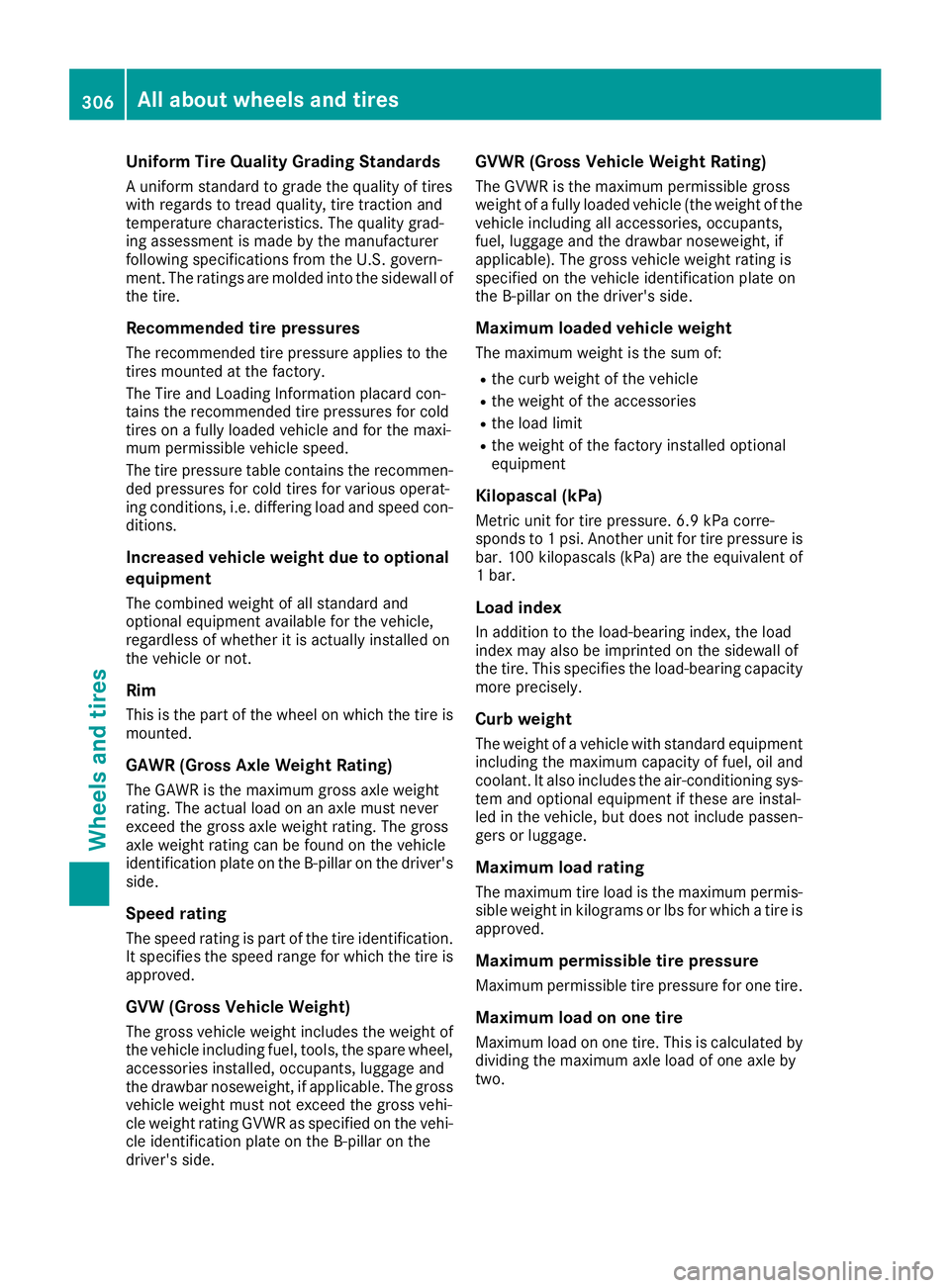
Uniform Tir eQ ualit yG rading StandardsAu nifor ms tandard to grade the quality of tires
with regards to tread quality, tire traction and
temperature characteristics. The quality grad-
ing assessmen tism ade by the manufacturer
following specification sf rom the U.S .g overn-
ment .T he ratings are molded int ot he sidewall of
the tire.
Recommended tir ep re ssuresThe recommended tire pressure applies to the
tires mounted at the factory.
The Tire and Loading Information placard con-
tains the recommended tire pressures for cold
tires on af ully loaded vehicle and for the maxi-
mum permissible vehicle speed.
The tire pressure table contains the recommen-
ded pressures for cold tires for various operat-
ing conditions, i.e. differin gl oad and speed con-
ditions.
Increased vehicle weight due to optional
equipment The combined weight of all standard and
optional equipment available for the vehicle,
regardless of whether it is actually installed on
the vehicle or not.
Rim This is the part of the wheel on which the tire is
mounted.
GAWR (Gross Axle Weight Rating) The GAWR is the maximum gross axle weight
rating. The actual load on an axle must never
exceed the gross axle weight rating. The gross
axle weight ratin gc an be found on the vehicle
identification plate on the B-pillar on the driver's
side.
Speed rating
The speed ratin gisp art of the tire identification.
It specifies the speed range for which the tire is
approved.
GVW (Gross Vehicle Weight)
The gross vehicle weight includes the weight of
the vehicle includin gf uel, tools, the spare wheel,
accessories installed, occupants, luggage and
the drawbar noseweight ,ifa pplicable. The gross
vehicle weight must not exceed the gross vehi-
cle weight ratin gG VWR as specified on the vehi-
cle identification plate on the B-pillar on the
driver' ss ide. GVW R( Gross Vehicle Weight Rating)The GVWR is the maximum permissible gross
weight of af ully loaded vehicle (the weight of the
vehicle includin ga ll accessories, occupants,
fuel, luggage and the drawbar n oseweight ,i f
applicable). The gross vehicle weight ratin gi s
specified on the vehicle identification plate on
the B-pillar on the driver' ss ide.
Maximum loaded vehicle weight The maximum weight is the sum of: R
the curb weight of the vehicle R
the weight of the accessories R
the load limit R
the weight of the factory installed optional
equipment
Kilopascal (kPa) Metric unit for tire pressure. 6.9 kPa corre-
sponds to 1p si. Another unit for tire pressure is
bar. 100 kilopascals (kPa) are the equivalent of
1b ar.
Load index In addition to the load-bearin gi ndex ,t he load
index may also be imprinted on the sidewall of
the tire. This specifies the load-bearin gc apacity
more precisely.
Curb weight The weight of av ehicle with standard equipment
includin gt he maximum capacit yoff uel, oil and
coolant .Ita lso includes the air-conditionin gs ys-
tem and optional equipment if these are instal-
led in the vehicle, but does not include passen-
gers or luggage.
Maximum load rating
The maximum tire load is the maximum permis-
sible weight in kilogram sorl bs for which at ire is
approved.
Maximum permissible tir ep re ssure
Maximum permissible tire pressure for one tire.
Maximum load on one tire
Maximum load on one tire. This is calculated by
dividing the maximum axle load of one axle by
two.306
All about wheels and tires
Wheels and tires
Page 314 of 326
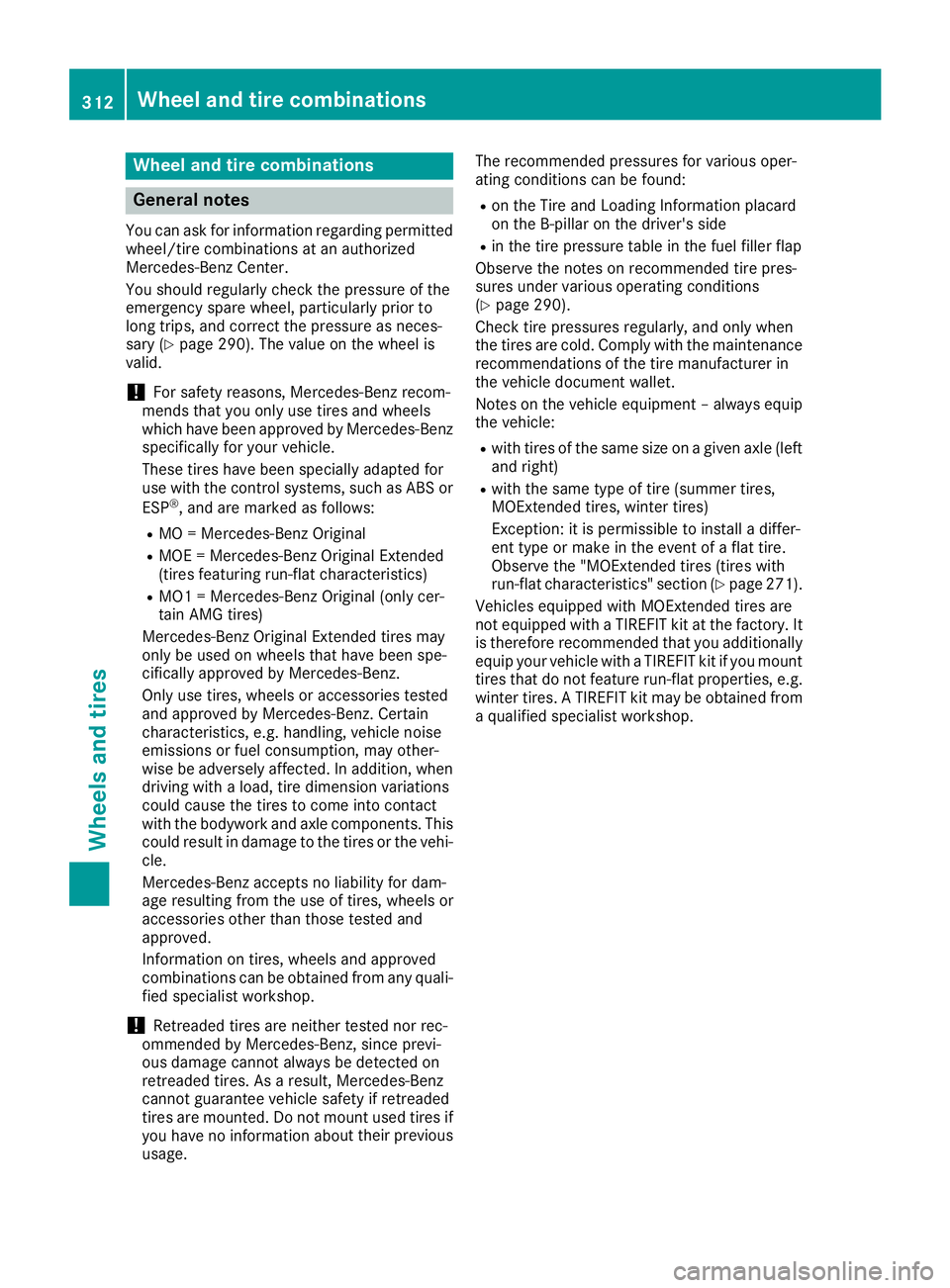
Whee la nd tire combinations
General notes You can ask for information regarding permitted
wheel/tire combinations at an authorized
Mercedes-Benz Center.
You should regularl yc heck the pressure of the
emergency spare wheel, particularly prio rt o
long trips, and correct the pressure as neces-
sary ( Y
pag e2 90). The valu eont he wheel is
valid.
! For safety reasons, Mercedes-Benz recom-
mends that you only use tires and wheels
which have been approved by Mercedes-Benz
specifically for you rv ehicle.
These tires have been speciall ya dapted for
use with the control systems, such as ABS or
ESP ®
,a nd are marked as follows:R
MO = M ercedes-Benz OriginalR
MOE = M ercedes-Benz Original Extended
(tires featuring run-fla tc haracteristics)R
MO1 = M ercedes-Benz Original (only cer-
tain AMG tires)
Mercedes-Benz Original Extended tires may
only be use donw heels that have been spe-
cifically approved by Mercedes-Benz.
Only use tires, wheels or accessories tested
and approved by Mercedes-Benz. Certain
characteristics, e.g. handling, vehicl en oise
emissions or fuel consumption, may other-
wis ebea dversely affected .Ina ddition, when
driving with al oad, tire dimension variations
coul dc aus et he tires to come into contact
with the bodywork and axle components. This
coul dr esult in damage to the tires or the vehi-
cle.
Mercedes-Benz accepts no liability for dam-
age resulting from the use of tires, wheels or
accessories other than those tested and
approved.
Informatio nont ires, wheels and approved
combinations can be obtained from any quali-
fied specialist workshop.
! Retreaded tires are neither tested nor rec-
ommende dbyM ercedes-Benz, since previ-
ous damage cannot alway sbed etected on
retreaded tires. As ar esult, Mercedes-Benz
cannot guarantee vehicl es afety if retreaded
tires are mounted .Don ot mount use dt ires if
you have no information abo ut thei r previous
u
sage. The recommende dp ressures for various oper-
ating conditions can be found: R
on the Tire and Loading Informatio np lacard
on the B-pillar on the driver's side R
in the tire pressure tabl eint he fuel filler flap
Observe the notes on recommende dt ire pres-
sure su nder various operating conditions
( Y
pag e2 90).
Check tire pressures regularly ,a nd only when
the tires are cold. Comply with the maintenance
recommendations of the tire manufacturer in
the vehicl ed ocument wallet.
Notes on the vehicl ee quipment –a lway se quip
the vehicle: R
with tires of the same size on ag ive na xle (left
and right) R
with the same type of tire (summer tires,
MOExtended tires, winter tires)
Exception: it is permissible to instal lad iffer-
ent type or make in the event of af lat tire.
Observe the "MOExtended tires (tires with
run-fla tc haracteristics" section ( Y
pag e2 71).
Vehicles equipped with MOExtended tires are
not equipped with aT IREFIT kit at the factory .I t
is therefore recommende dt hat you additionally
equip you rv ehicl ew ith aT IREFIT kit if you mount
tires that do not feature run-fla tp roperties, e.g.
winter tires. AT IREFIT kit may be obtained from
aq ualified specialist workshop.312
Whee la nd tire combinations
Wheels and tires